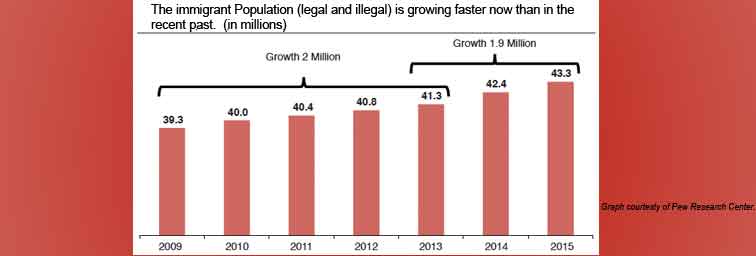
Growth of Foreign-Born Population Surges as U.S. Economy Recovers
- David Simcox
- November 15, 2016
- Forum Papers
- Forum Paper
- 0 Comments
![]() Your gift helps publish and distribute materials like this.
Your gift helps publish and distribute materials like this.
Click here for a downloadable, printable PDF version
Growth of Foreign-Born Population Surges as U.S. Economy Recovers
Summary and Introduction
Census projections proclaim that, with Americans’ fertility falling and deaths soon to begin rising, immigration – not natural increase – will become the principal driver of U.S. population growth as early as 2023 (Rubenstein, 2016).
A September 2014 Census projection estimated that, despite some slowing growth attributed to the 2008 recession and aftermath, as well as to improved conditions within Mexico since 2000, the nation’s foreign-born population reached 43.2 million in 2015. This represents a net increase of 12.2 million – a rise of almost 40 percent – since 2000 after subtracting emigration and deaths of the foreign-born (Colby and Ortman, 2015).
The 43.2 million figure would include legal and illegal immigrants, plus nearly 2.0 million foreign-born sojourners living in the country under the increasing number of long-term but nominally temporary visa, parole and deferred deportation arrangements. This would include: perennial students, temporary workers of all skill levels, investors, treaty traders, journalists, international civil servants and businessmen, and special protected classes of aliens.
The latest Census projections (2014) show net immigration rising from 1.2 million annually in 2015 to just under 1.5 million in 2060, with total U.S. population reaching 417 million. In 2023, population gains from immigration would surpass natural increase. In that same year, the share of the foreign-born (14.8 percent) will supersede the previous U.S. all-time record of 14.7 percent set in 1910. By 2040 natural increase would have declined to 0.5 million, while net immigration will have climbed to 1.43 million – with the large spread projected to grow through 2060. In 2060 the foreign-born share of the total population would reach 18.8 percent, or 78 million persons. Of the 196.6 million births projected in the U.S. between 2015 and 2060, 40 percent would be to foreign-born mothers.
Five years earlier in its 2009 projections, Census calculated net immigration as larger – reaching 2.0 million in 2060 versus 1.5 million assumed in its 2014 projections. But the indications are strong that the 2.0 million projections are more likely in view of the tendency of the U.S. immigration system, with its enforcement and regulatory flexibility and its absence of hard ceilings, to increase intake in the absence of explicit statutory changes. Accepting the higher estimates of net immigration, the U.S. population by 2060 would be nearer the 439 million projected in 2009 than the 2014 projection of 417 million.
Continue reading click here.
David Simcox is a former NPG Senior Advisor. From 1985 to 1992 he was executive director of the Center for Immigration Studies, a Washington, D.C.-based think tank. From 1956 to 1985, Simcox was a career diplomat of the U.S. Department of State, with service in diplomatic posts in Latin America, Africa, Europe, and in Washington. His diplomatic assignments involved formulation of policy for labor, population and migration issues in such countries as Mexico, Panama, Dominican Republic, Brazil and the nations of Indo-China. Simcox is a frequent contributor on population, immigration and Latin American matters to national newspapers and periodicals and has testified on several occasions before congressional committees on immigration, labor and identification policies. He holds degrees from the University of Kentucky, American University and the National War College. Simcox is a veteran of the U.S. Marine Corps and saw service in the Korean conflict. If you are affiliated with the media and would like to schedule an interview with David, please contact us at 703-370-9510.
